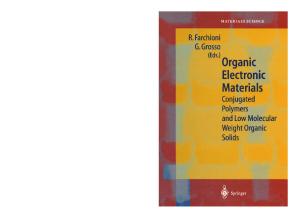New Conducting and Semiconducting Polymers for Organic Photovoltaics
- PDF / 204,062 Bytes
- 6 Pages / 612 x 792 pts (letter) Page_size
- 82 Downloads / 425 Views
1270-HH14-40
New Conducting And Semiconducting Polymers For Organic Photovoltaics Shawn Sapp and Silvia Luebben* TDA Research, Inc. Wheat Ridge, Colorado 80033 ABSTRACT In the emerging field of low-cost printed electronics there is a lack of solvent processable conducting and semiconducting materials with highly tuned and known electronic properties. Currently the best performing conductors and semiconductors are not sufficient to produce truly printable, cost competitive organic photovoltaics (OPVs). TDA Research, Inc. (TDA) has been investigating a new class of solvent processable intrinsically conducting polymers for use as charge transport and transparent conducting layers in organic electronic devices. We have also begun the manufacture of electron-deficient semiconducting polymers that may prove to be excellent acceptors in bulk hetero-junction OPVs. This paper presents a summary of the materials characterization conducted on TDA’s new electronic materials and how these may address several of the pressing issues preventing the realization of low-cost, printed solar cells and flexible electronics devices. INTRODUCTION ICPs are polymers with extended pi conjugation along the molecular backbone, and their conductivity can be changed by several orders of magnitude from a semiconducting state to a metallic state by doping. P-doping is achieved by partial oxidation of the polymer by a chemical oxidant or an electrochemical method, and causes depopulation of the bonding pi orbital (HOMO) with the formation of “holes” [1]. Despite the promises of ICPs since their discovery in the 70s, relatively few commercial products have succeeded, primarily because of their limited performance and inherent insolubility, which makes processing difficult. PEDOT is one of the most commonly used ICPs because of its good electrical conductivity, environmental stability in the doped (conducting) form, and reasonable optical transparency when used as a thin film [2]. A common way to apply a PEDOT coating is to use a water dispersion consisting of a blend of PEDOT and the polyanion poly(styrene sulfonate) or PEDOT-PSS. Doped PEDOT-PSS blends are manufactured by H.C. Starck and are marketed under the trade name of Clevios® P. Several grades of Clevios® P are available from Sigma-Aldrich (655201, 483095, 560596). A low-conductivity grade has been successfully employed as the hole injection layer in organic LEDs (OLEDs) and OPVs and the high conductivity grades are being evaluated as transparent conductors with work functions of ca. 5.1 eV [3,4]. DISCUSSION Despite the success of the PEDOT-PSS blends, it has been shown that the presence of the strongly acidic and hygroscopic PSS can sometimes degrade device lifetime and performance [57]. With recent advances in flexible, printed electronic devices, there is increasing interest in optically transparent conducting polymer materials that can be processed from non-hygroscopic solvents and that will wet hydrophobic plastic substrates. TDA Research, Inc. (TDA) developed and manufactures solvent-d
Data Loading...









